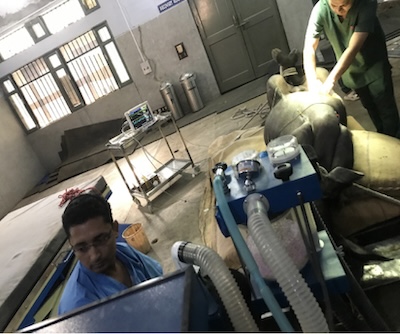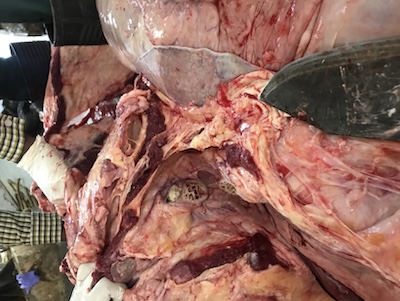
DIAPHRAGMATIC HERNIA
Pashu Sandesh, 18 October 2023
Ankit Dangi1and Devika Dangi2
1. Assistant Professor, Veterinary Surgery and Radiology, International Institute of Veterinary Education & Research, Rohtak
2. Animal Nutrition, Lala Lajpat Rai University of Veterinary & Animal Sciences, Hisar
Diaphragmatic hernia (DH) is a thoracic-digestive disorder in which there is the evisceration of abdominal viscera into the thoracic cavity through a congenital or acquired defect in the diaphragm. The continuity of the diaphragm is disrupted such that abdominal organs can migrate into the thoracic cavity.
Abdominal organs that herniate:
- Most commonly- Reticulum
- May get involved – omasum, abomasums, loops of intestine, spleen or liver
It causes chronic ruminal tympany, anorexia and displacement of the heart. It is a chronic wasting and inflammatory disorder in adult buffaloes and cows, and also in buffalo bulls. In small animals mostly it is caused by trauma.
Aetiology:
- Weakening of the diaphragm by the lesions of TRP.
- Congenital weak points of the diaphragm.
- Increased abdominal pressure during pregnancy or parturition.
- Foreign body – reticular contraction – pricking of the diaphragm constantly – perforation.
- Areas at the junction of muscular and tendinous portion – more prone – lack of tone and thickness.
- Trauma
Buffaloes are more prone than cattle:
- The right ventromedial tendinous zone is much thinner
- Pericardiophrenic vessels missing
- Lesser collagen content
Clinical signs:
- Recurrent tympany – proportional to the portion of reticulum herniated – more severe adhesions.
- Aspiratory pneumonia – regurgitation – adhesions cause distortion and derangement in normal alignment of oesophageal groove, cardia and reticulo-omasal opening – sojourn of ingesta in forestomach.
- Abrupt fall in milk yield.
- Scant defecation or diarrhoea with a foul smell.
- Brisket oedema with or without jugular pulsation.
- Abduction of elbow.
- Chronic cough rarely.
- If untreated – inanition – progressive emaciation
– dehydration – death.
- Suspended rumination.
Diagnosis:
- Clinical signs
- Auscultation – muffled cardiac sounds, reticular sounds cranial to 6th rib.
- Roentgenograms/Radiography:(contrast or simple)
- Right lateral recumbency – most hernia in right hemidiaphragm.
- Supine position – lateral projection – empty reticulum appears as an air-filled viscous in the thoracic cavity.
- Exploratory rumenotomy
- Ultrasonography
Treatment:


Firstly:
Laprorumenotomy
- Complete evacuation of rumen
- Removal of any foreign body if present
- Add prebiotic and probiotic
Secondly :
Herniorrhaphy
- Ventral midline abdominal post-xiphoid approach
- Off-feed for 48 hours following rumen evacuation
- i/v fluids during fasting (polyionic solutions with dextrose)
- Regular monitoring- ECG, pulse rate, SpO2, blood pressure, heart rate.
- Negative pressure within the chest cavity is created by suction of air under a water seal
- Extensive adhesions with the pulmonary lobe require partial or complete lobectomy
- Postoperative considerations
- Antibiotics for 5 – 7 days
- Analgesic for 3 - 5 days.
- Fluid therapy
- Easily digestible feed
- Pregnant animal – check for viable foetus
- Suture ASD and removal after 10 – 12 days
- Consider vet advice regularly









































































